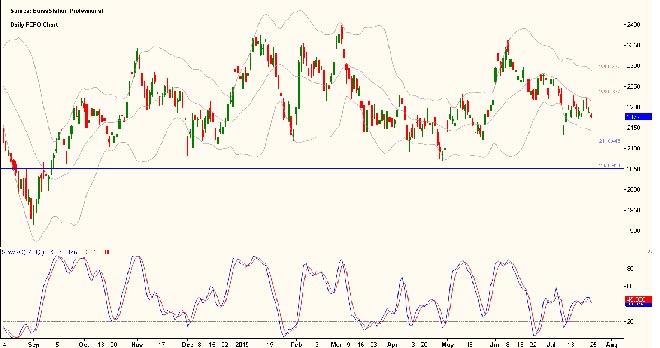 Malaysian palm oil futures was pressured lower on Friday to 2,177, while trading remained thin for the week following the Muslim fasting month holiday period.
Malaysian palm oil futures was pressured lower on Friday to 2,177, while trading remained thin for the week following the Muslim fasting month holiday period.
Future Crude Palm Oil (FCPO) benchmark October 2015 contract settled at 2,177 on Friday, down 13 points or 0.6 per cent from 2,190 last Friday.
Trading volume decreased to 78,195 contracts from 93,777 contracts from last Monday to Wednesday.
Open interest based decreased to 545,252 contracts from 561,154 contracts from last Monday to Wednesday.
Cargo surveyor, Intertek Testing Services (ITS), reported that exports of Malaysia’s palm oil products during July 1 to 20 decreased 15.5 per cent to 907,574 tonnes compared with 1.074 million tonnes during June 1 to 20.
Another cargo surveyor, Societe Generale de Surveillance (SGS), reported that Malaysia’s palm oil exports during July 1 to 20 decreased 16.1 per cent to 907,627 tonnes compared with 1.082 million tonnes during June 1 to 20.
Overall, demand weakened from India, the US, and the European Union (EU), while demand strengthened from the US, more than doubling purchases of palm oil during the July 1 to 20 period.
Spot ringgit was barely changed on Friday to 3.8080, as the central bank was spotted intervening to support the ringgit which is the worst-performing Asian currency of the year so far, traders said.
Indonesia, the world’s top producer of palm oil, said it would begin imposing levies on exports on Thursday, in a bid to boost the government’s coffers.
Russia has considered imposing limits on the use of palm oil in food production, Deputy Prime Minister Arkady Dvorkovich was quoted as saying by Russian news agencies on Wednesday.
On Monday, the price fell for the third consecutive day, while staying within a tight range, touching the lowest in more than a week, as poor exports and a strong dollar added pressure on the market.
On Tuesday, the price rose, rebounding from last session’s one and a half-week low on expectations of a drop in output due to holidays at the end of the Muslim fasting month of Ramadan.
On Wednesday, the price retreated from a one-week high, with traders saying that they expected an increase in production in the third quarter that could eliminate any shortage of the edible oil resulting from low output in July.
On Thursday, the price fell, for the second consecutive day, while trading remained quiet following declines in competing markets and news of Russia considering limits on the use of the tropical oil.
On Friday, the price declined for a third consecutive day, while trading continued to be thin following the Muslim fasting month holiday period.
Volumes should pick-up this coming week with the input of new export data and the return of more players to the market, traders said.
Technical analysis
According to the weekly FCPO chart, the price opened below the middle Bollinger band, and within the previous week sideways range at 2,135 to 2,185.
By the end of the week, the price tested the middle Bollinger band, closing below.
The price continued to remain under pressure by psychological barrier at 2,200, and is unable to break above for the last three weeks.
A doji candlestick was formed, indicating that market players are unsure of the market’s direction and are waiting further catalysts.
According to the daily FCPO chart, on Monday, the price opened above the bottom Bollinger band and within previous week sideways range. By the later session, the price tested the sideways resistance level at 2,185 and closing above.
The price might attempt to break above the sideways range and test the psychological barrier at 2,200 in the near term.
On Tuesday, the price opened above the sideways range, and below the psychological level 2,200.
By the later session, the price tested the psychological level at 2,200, closing above, and the price tested the middle Bollinger band, closing below.
On Wednesday, the price opened above the psychological barrier 2,200 and below the middle Bollinger band.
By the later session, the price tested the middle Bollinger band, closing below, and testing the psychological barrier at 2,200, closing above.
On Thursday, the price opened above the previous sideways range, and below the psychological barrier at 2,200, while a downside gap was formed from 2,190 to 2,210 which might be covered in the near term.
By the later session, the previous gap was unable to be covered, while the price tested the psychological barrier at 2,200, closing below.
A gravestone doji formed indicating that there could be a reversal of the current trend in the near term, as the price is unable to break above the psychological barrier 2,200.
On Friday, the price opened within the sideways range 2,135 to 2,185, and below the middle Bollinger band. A downside gap was formed from 2,180 to 2,190, which might be covered in the near term.
By the later session, the price tested the sideways resistance level at 2,185, closing below.
In the coming week, the price has potential to range between 2,130 and 2,230.
Resistance lines will be placed at 2,230 and 2,290, while support lines will be positioned at 2,110 and 2,050. These levels will be observed this coming week.
Major fundamental news this coming week
ITS and SGS report released on the July 27 and 31 (Monday and Friday).
Oriental Pacific Futures (OPF) is a Trading Participant and Clearing Participant of Bursa Malaysia Derivatives. You may reach us at www.opf.com.my. Disclaimer: This article is written for general information only. The writers, publishers and OPF will not be held liable for any damage or trading losses that result from the use of this article.
